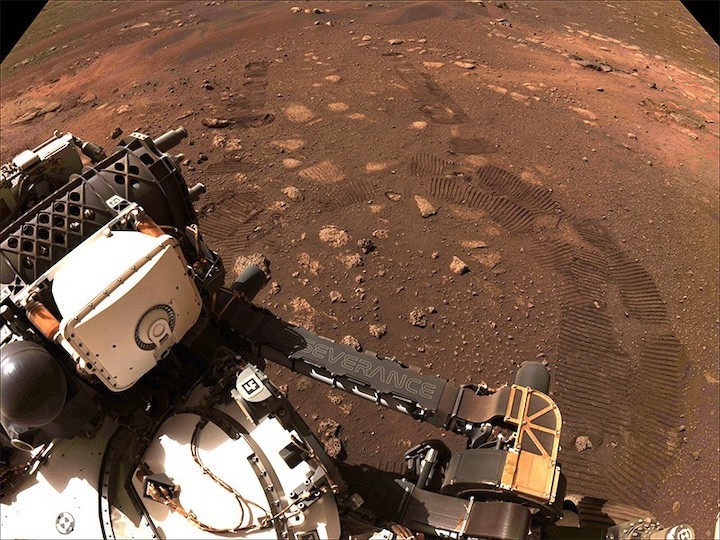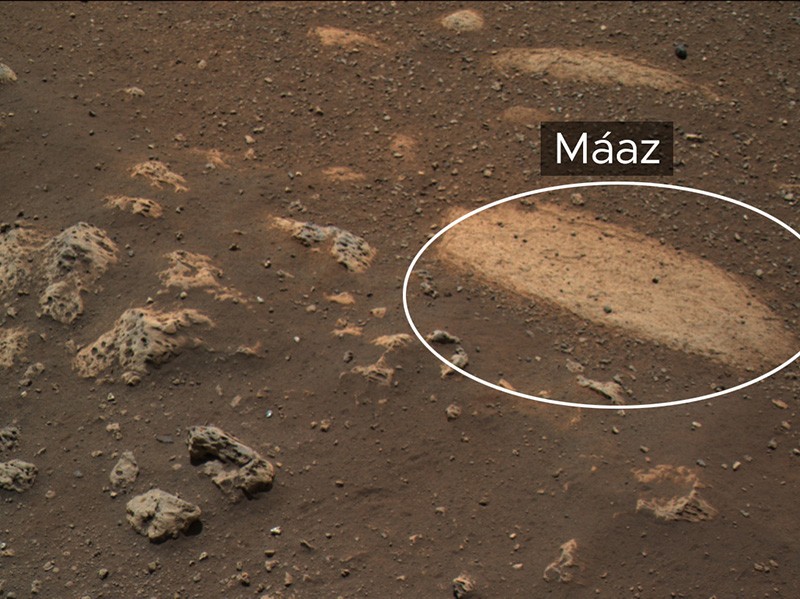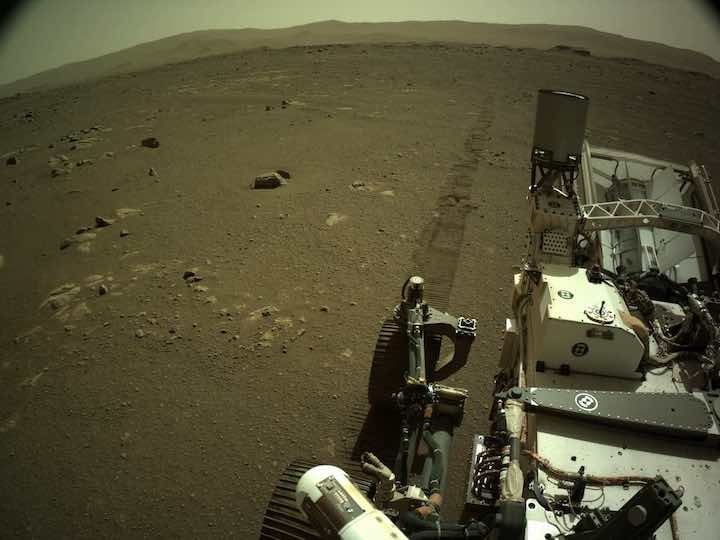12.03.2021
NASA preparing to fly Ingenuity Mars drone, enabling future airborne missions
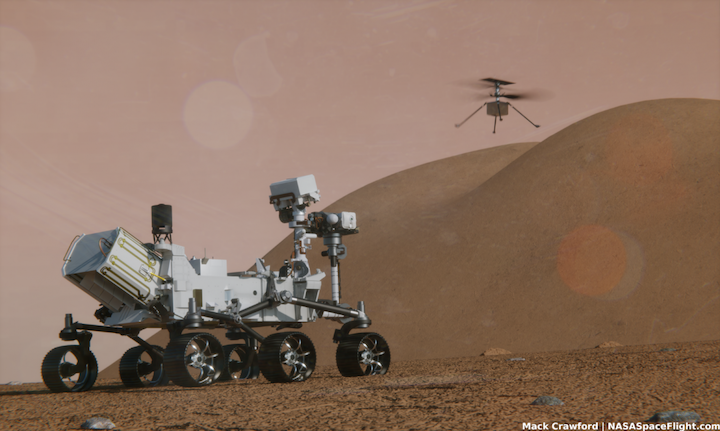
As NASA’s newest Mars rover, Perseverance, continues its own checkouts and tests, work is starting for a new phase of the mission – the Ingenuity helicopter. This first-of-its-kind piece of hardware will demonstrate (non-rocket) powered flight on a world other than Earth for the first time. Data from these flights – expected to begin in 30-60 days – will help to develop future programs for missions to Mars and beyond.
Ingenuity is an experimental addition to the Mars 2020 mission. No matter the results of its test campaign, it will not have a significant effect on the primary mission.
Teams are planning for a 30 day flight window for the helicopter. They currently aim for a minimum of one flight, but that has the possibility of being extended. The first flight will feature a relatively simple 20-30 second low altitude hover test before landing. Afterwards, flights will last longer and travel farther.
Ingenuity features a pair of coaxial, 1.2 meter long, carbon fiber rotors. “Coaxial” means that the rotors are stacked on top of each other and spin in opposite directions, dramatically increasing the lift with a minimal increase in area.
The rotors will spin at a rate of 2,400 rotations per minute (RPM) – far higher than the approximately 500 RPM of many Earth-based helicopters. The rotors need to spin fast to account for the extremely thin Martian atmosphere.

Ingenuity after assembly at NASA’s Jet Propulsion Laboratory (JPL). The carbon fiber patterns on the rotors and legs are visible. Credit: NASA.
The helicopter is powered by a single solar array above the rotors which charges six lithium-ion batteries. These batteries will enable Ingenuity to fly for up to 90 seconds at a time. A single 90 second flight – the maximum flight time of Ingenuity – will consume approximately 8.75 watt-hours – less energy than in an iPhone 12 battery.
Four carbon fiber legs sticking out of the corners of the main body will absorb any extra velocity and shocks upon landing.
The combination of its small size and large amount of composite materials makes Ingenuity especially light, massing 1.8 kilograms. On Earth, this equates to 17.7 Newtons (4.0 pounds), but in Mars‘ lower gravity, Ingenuity weighs only 6.7 Newtons (1.5 pounds).
Once it is deployed from Perseverance, Ingenuity will communicate with Earth through the rover. Each has a small antenna to talk to each other, and the rover will relay data back to Earth using its more powerful communications suite.
Throughout the cruise to Mars, Ingenuity communicated and received power directly through Perseverance.
On August 13, 2020, NASA announced that the helicopter was powered on and recharged in space for the first time. This was approximately two weeks after launch. The batteries were only charged to 35%, since each full charge and discharge of lithium-ion batteries slightly reduces their longevity. Keeping them at a low-to-medium charge level minimizes this impact.
Engineers then repeated this test approximately every two weeks during the cruise to Mars.
Perseverance – with Ingenuity attached on its belly – touched down on Mars on February 18, 2021.
The helicopter is currently still connected to Perseverance, as the latter completes its checkouts and initial operations on the Martian surface.
On March 2, the rover successfully deployed and tested its robotic arm. The arm contains several instruments and cameras, most notably the rover’s drill. It also features the PIXL and SHERLOC instruments – containing an x-ray and ultraviolet spectrometer, respectively. These will enable more detailed analysis of surface materials.

A view of the Martian surface – featuring fresh tire tracks – as seen by Perseverance after its maiden drive on March 4. Credit: NASA.
Two days later, on March 4, Perseverance completed its first drive across Mars. The 6.5 meter (21.3 feet) trek gave rover operators and mission planners at NASA’s Jet Propulsion Laboratory (JPL) their first opportunity to test out and calibrate the rover’s motors. The short drive consisted of a four meter move forward, a 150 degree left turn, and a final 2.5 meter drive in reverse. The team reported that the rover’s performance was excellent.
They are now beginning the search for a flat and clear area of land – appropriately nicknamed the “helipad” – at which Ingenuity will be deployed. Once Perseverance finds and moves to such a location, the team will command the rover to deploy Ingenuity. This will take place approximately 30 days after landing.
The deployment process consists of several steps to deliver the helicopter to the Martian surface.
First, the cover protecting Ingenuity will be jettisoned, and Perseverance will drive away. Then, the first connections to the helicopter will be cut, and two of its landing legs will be deployed – rotating it away from the belly of the rover. It will then be rotated to a fully upright position under the rover, where its final two legs will be deployed.
Perseverance will then drop Ingenuity onto the surface, and drive away to a safe distance.
Ingenuity‘s solo test campaign will begin with a series of internal checkouts, notably testing whether it can maintain a stable temperature and recharge its batteries using its small solar panel.
Should all these steps be completed successfully, the rotors will then be spun up to a high speed, although not fast enough to lift the vehicle off the surface. This will ensure the motors are working nominally and clear the vehicle for flight.
As previously discussed, the initial flight will last 20-30 seconds, and consist of Ingenuity hovering at a small altitude above the surface. Should that flight be a success, later ones will see the helicopter perform more complex operations.
The current test window will last only 30 days, but that is likely to be extended if Ingenuity is performing well.
Ingenuity marks the beginning of otherworldly flight. No matter the outcome, it will provide a trove of data to help the designers of future off-Earth helicopters.
The first such mission will be Dragonfly, a large, eight-rotor drone which will explore a portion of Saturn’s largest moon, Titan. Dragonfly will be similar in size to Perseverance, and actually use an identical Multi-Mission Radioisotope Thermoelectric Generator (MMRTG) for power.
The MMRTG will charge Dragonfly’s batteries during the Titan night, enabling 30-minute long flights and data downlink during the day.
Dragonfly will feature a host of experiments to study Titan’s atmosphere, surface composition, and seismology. It will be the second mission to Titan, after Huygens in 2005.
Dragonfly is set to launch in 2027, and land on Titan in 2036.
Quelle: NS
----
Update: 16.03.2021
.
Perseverance SuperCam science instrument delivers first results
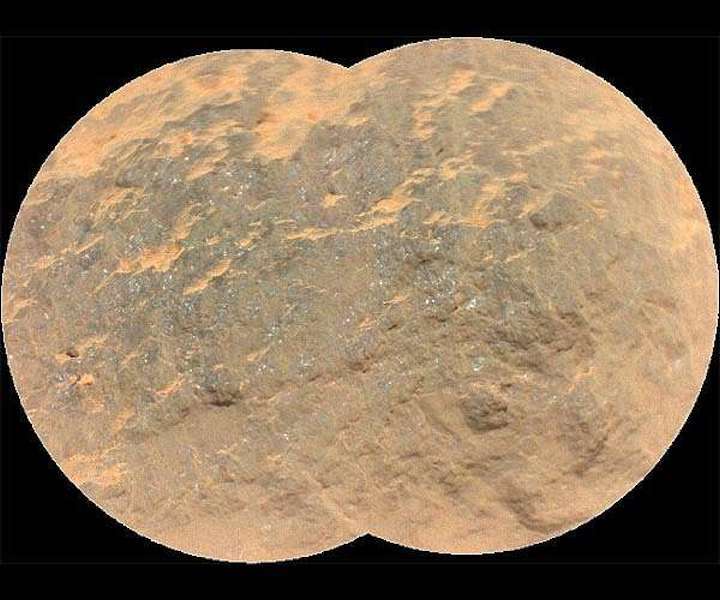
Combining two images, this mosaic shows a close-up view of the rock target named "Yeehgo" from the SuperCam instrument on NASA's Perseverance rover on Mars. The component images were taken by SuperCam's Remote Micro-Imager (RMI) on March 7, 2021 (the 16th Martian day, or sol, of Perseverance's mission on Mars). To be compatible with the rover's software, "Yeehgo" is an alternative spelling of "Yeigo," the Navajo word for diligent. The target is 10.9 feet (3.325 meters) from the rover. Each of the two images in the mosaic shows a field of view 2.5 inches (6.2 centimeters) in diameter. Perseverance's Navigation Cameras (Nav Cam) and Mastcam-Z instrument also took images of that area at the same time to provide multiple views of the rock target, as seen in the annotated version of this image.
The first readings from the SuperCam instrument aboard NASA's Perseverance rover have arrived on Earth. SuperCam was developed jointly by the Los Alamos National Laboratory (LANL) in New Mexico and a consortium of French research laboratories under the auspices of the Centre National d'Etudes Spatiales (CNES). The instrument delivered data to the French Space Agency's operations center in Toulouse that includes the first audio of laser zaps on another planet.
"It is amazing to see SuperCam working so well on Mars," said Roger Wiens, the principal investigator for Perseverance's SuperCam instrument from Los Alamos National Laboratory in New Mexico. "When we first dreamed up this instrument eight years ago, we worried that we were being way too ambitious. Now it is up there working like a charm."
Perched atop the rover's mast, SuperCam's 12-pound (5.6-kilogram) sensor head can perform five types of analyses to study Mars' geology and help scientists choose which rocks the rover should sample in its search for signs of ancient microbial life. Since the rover's Feb. 18 touchdown, the mission has been performing health checks on all of its systems and subsystems. Early data from SuperCam tests - including sounds from the Red Planet - have been intriguing.
"The sounds acquired are remarkable quality," says Naomi Murdoch, a research scientist and lecturer at the ISAE-SUPAERO aerospace engineering school in Toulouse. "It's incredible to think that we're going to do science with the first sounds ever recorded on the surface of Mars!"
On March 9, the mission released three SuperCam audio files. Obtained only about 18 hours after landing, when the mast remained stowed on the rover deck, the first file captures the faint sounds of Martian wind.
The wind is more audible, especially around the 20-second mark, in the second sound file, recorded on the rover's fourth Martian day, or sol.
SuperCam's third file, from Sol 12, includes the zapping sounds of the laser impacting a rock target 30 times at a distance of about 10 feet (3.1 meters). Some zaps sound slightly louder than others, providing information on the physical structure of the targets, such as its relative hardness.
"I want to extend my sincere thanks and congratulations to our international partners at CNES and the SuperCam team for being a part of this momentous journey with us," said Thomas Zurbuchen, associate administrator for science at NASA Headquarters in Washington.
"SuperCam truly gives our rover eyes to see promising rock samples and ears to hear what it sounds like when the lasers strike them. This information will be essential when determining which samples to cache and ultimately return to Earth through our groundbreaking Mars Sample Return Campaign, which will be one of the most ambitious feats ever undertaken by humanity."
The SuperCam team also received excellent first datasets from the instrument's visible and infrared (VISIR) sensor as well as its Raman spectrometer. VISIR collects light reflected from the Sun to study the mineral content of rocks and sediments. This technique complements the Raman spectrometer, which uses a green laser beam to excite the chemical bonds in a sample to produce a signal depending on what elements are bonded together, in turn providing insights into a rock's mineral composition.
"This is the first time an instrument has used Raman spectroscopy anywhere other than on Earth!" said Olivier Beyssac, CNRS research director at the Institut de Mineralogie, de Physique des Materiaux et de Cosmochimie in Paris.
"Raman spectroscopy is going to play a crucial role in characterizing minerals to gain deeper insight into the geological conditions under which they formed and to detect potential organic and mineral molecules that might have been formed by living organisms."
Quelle: SD
----
Update: 17.03.2021
.
A month on Mars: what NASA's Perseverance rover has found so far

